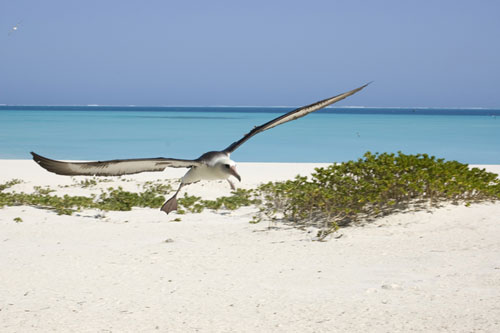Erin Simons (Department of Anatomy, Midwestern University, Glendale, Arizona, USA) and Patrick O'Connor have looked at Laysan Albatrosses Phoebastria immutabilis to see if their dynamic soaring mode of flight is reflected in their wing bone structure, publishing in The Anatomical Record.
The paper's abstract follows
"Wing bone histology in three species of birds was characterized in order to test hypotheses related to the relationship between skeletal microstructure and inferred wing loading during flight. Data on the degree of laminarity (the proportion of circular vascular canals) and the occurrence of secondary osteons were obtained from three species that utilize different primary flight modes: the Double-crested cormorant, a continuous flapper; the Brown pelican, a static soarer; and the Laysan albatross, a dynamic soarer. Laminarity indices were calculated for four quadrants for each of the three main wing elements. Ulnae and carpometacarpi were predicted to exhibit quadrant specific patterns of laminarity due to hypothesized differences in locally applied loads related to the attachment of flight feathers. However, few differences among the quadrants were identified. No significant differences were identified among the three elements, which is notable as different bones are likely experiencing different loading conditions. These results do not support the concept of bone functional adaptation in the primary structure of the wing elements. Significant differences in laminarity were found among the three primary flight modes. The dynamic soaring birds exhibited significantly lower laminarity than the flapping and static soaring birds. These results support the proposed hypothesis that laminarity is an adaptation for resisting torsional loading. This may be explained by overall wing shape: whereas dynamic soaring birds have long slender wings, flappers and static soaring birds have broader wings with a larger wing chord that would necessarily impart a higher torsional moment on the feather-bearing bones."

Laysan Albatross. Photograph by James Lloyd
Reference:
Simons, E.L.R. & O'Connor, P.M. 2012. Bone laminarity in the avian forelimb skeleton and its relationship to flight mode: testing functional interpretations. The Anatomical Record: Advances in Integrative Anatomy and Evolutionary Biology 295: 386-396.
John Cooper, ACAP Information Officer, 2 March 2012

 Français
Français  English
English  Español
Español